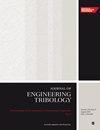考虑起动过程中磨损行为的滑动轴承瞬态摩擦动力学性能
IF 1.8
3区 工程技术
Q3 ENGINEERING, MECHANICAL
Proceedings of the Institution of Mechanical Engineers, Part J: Journal of Engineering Tribology
Pub Date : 2023-07-10
DOI:10.1177/13506501231187316
引用次数: 1
摘要
将瞬态摩擦动力学与磨损模型相结合,研究了启动过程中的混合润滑磨损行为。耦合数值模型考虑了瞬态混合润滑行为对磨损的影响,包括膜厚随磨损深度的方程和时变磨损系数。在本研究中,预测了磨损和混合润滑性能随时间分布的演变,并评估了加速方式、加速时间、外载荷、润滑剂粘度和启动时间对数值预测的影响。研究结果表明,磨损行为,特别是在分析加速度方式和加速度时间的影响时,对轴承-转子系统启动性能的评估有重大影响,甚至改变了最优参数的确定。此外,参数化研究表明,磨损和混合润滑性能对外载荷和润滑剂粘度敏感。最后,对启动时间影响的研究表明,适当的磨损几何形状促进了流体动力效应,但严重磨损的轴承表面对启动有负面影响。本文章由计算机程序翻译,如有差异,请以英文原文为准。
Transient tribo-dynamic performance of journal bearings considering wear behavior during start-up
The transient tribo-dynamics and wear model are coupled to study the mixed lubrication-wear behavior during start-up. The coupled numerical model involves the film thickness equation with wear depth and a time-varying wear coefficient to account for the impact of transient mixed lubrication behavior on wear. In this study, the evolution of wear and mixed lubrication performance distribution over time is predicted, and the impact of acceleration mode, acceleration time, external load, lubricant viscosity, and start-up time on the numerical predictions is evaluated. The findings demonstrate that wear behavior, particularly in the analysis of the effects of acceleration mode and acceleration time, has a significant impact on the evaluation of the bearing-rotor system's start-up performance and even changes the determination of optimal parameters. Furthermore, the parametric study demonstrates that wear and mixed lubrication performance are sensitive to the external load and lubricant viscosity. Finally, studies on the effect of start-up times show that proper wear geometry promotes hydrodynamic effects, but severely worn bearing surfaces have a negative effect on start-up.
求助全文
通过发布文献求助,成功后即可免费获取论文全文。
去求助
来源期刊

CiteScore
4.20
自引率
5.00%
发文量
110
审稿时长
6.1 months
期刊介绍:
The Journal of Engineering Tribology publishes high-quality, peer-reviewed papers from academia and industry worldwide on the engineering science associated with tribology and its applications.
"I am proud to say that I have been part of the tribology research community for almost 20 years. That community has always seemed to me to be highly active, progressive, and closely knit. The conferences are well attended and are characterised by a warmth and friendliness that transcends national boundaries. I see Part J as being an important part of that community, giving us an outlet to publish and promote our scholarly activities. I very much look forward to my term of office as editor of your Journal. I hope you will continue to submit papers, help out with reviewing, and most importantly to read and talk about the work you will find there." Professor Rob Dwyer-Joyce, Sheffield University, UK
This journal is a member of the Committee on Publication Ethics (COPE).
 求助内容:
求助内容: 应助结果提醒方式:
应助结果提醒方式:


